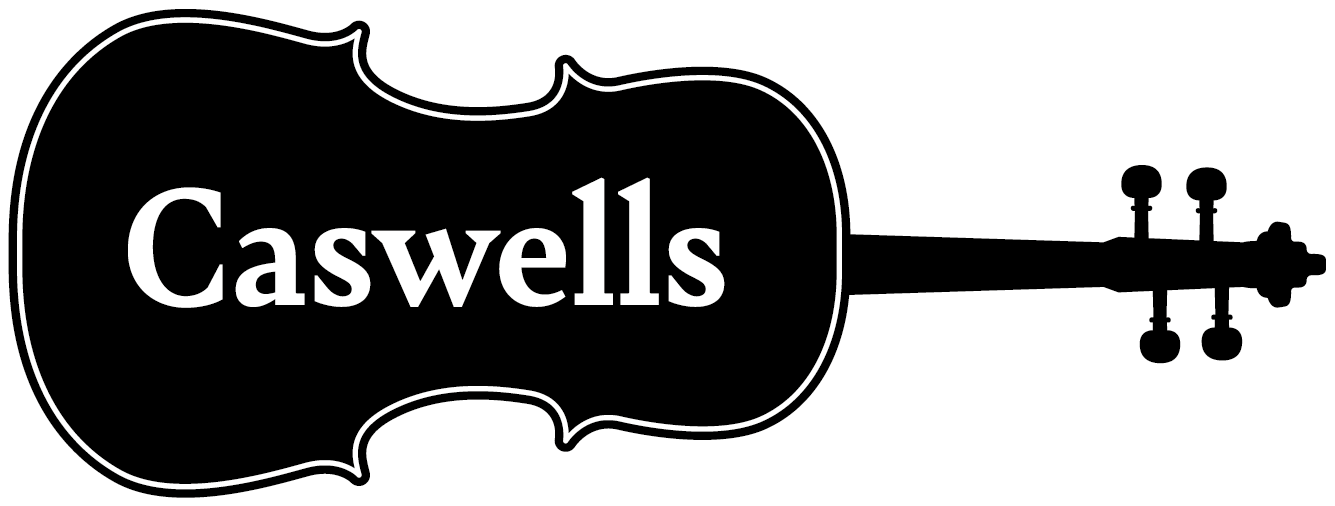There is often some confusion surrounding string gauge and tension for bowed stringed instruments. For this article, I will concentrate on Violin strings, but the same principles apply to Viola, Cello and Bass.
The gauge of a string is the measurement of its diameter or in other words, its thickness. This was easily measured in the old Gut string era. The string was simply slotted a v-shaped tool which indicated the thickness – from which the weight was calculated and hence the downward pressure on the bridge.
With modern wound strings, this is not possible as thicknesses vary – thus the measurement is one of ‘tension’ from which again the downward pressure on the violin bridge can be calculated. The tension of the strings thus defines the pressure on the bridge – the higher the bridge and smaller the angle of the strings at the bridge, the greater will be the pressure on the bridge.
With modern strings, some manufacturers will list the actual tension, while others just offer a description such as, Hard, forte, stark or heavy – medium, mittel – or soft, thin, dolce, light etc.
In principle, the harder or stronger the string, it will result in a louder, fuller, and more powerful sound, but may also result in a slower response time. But also bear in mind that the violin must be robust, with a strong bridge and soundpost, otherwise you could damage your instrument. Generally, for older more delicate violins, the hard strings should be avoided.
Medium tension strings are the most popular today because they have been designed by the manufacturer to give an even, balanced tone and response. Once again the right string for you will be arrived at by some trail and experimentation, but I recommend that you try medium tension strings first when experimenting with new strings.
Thin or soft strings, require less tension to bring them up to pitch. They are used to soften up the tone of an instrument. These are less commonly used except in specific circumstances. Some professional players will mix their strings to achieve the right balance and sound for the instrument they are using, and it is not uncommon to fit a soft string to achieve this. I well remember a lovely old Cello which had a unusually thin table, to the extent that an overly tight soundpost actually dented upward. A set of soft Jargars was the only answer and resulted in a sweet, focused sound.
All this is important, but it is simply one of achieving the right balance between you, your instrument and the sound you wish to achieve.
Next week we will discuss actual strings.
Lance




Also, Correctly Spooling the Strings onto the Pegs is so much more important than what they will look like to the eye, which they will if Spooled correctly. When looking at a Stringed Instrument that is tuned for playing, look not as a ‘Player’ but look at it with a Mechanical Mind set. The Instrument then becomes a load bearing tensioning machine not unlike an industrial Winch, c/w Drum, Line, Motor and Brake which the operator controls. In the instruments case, each tuning Peg is the Drum, Each String is the Line,the Motor is our Fingers that wind the Peg and the Friction applied to the Peg against the Peg Hole is the Brake which retains the String Tension. In the String’s case one end is fixed and the other is wound up until the correct tension has been applied that is acquired by note sound achieved. En-route from the Fixed end at the Tail Piece, the String travel over the Bridge, then to the Nut groove and then to and around the Peg. So what does an Instrument String have in common with any other sort of line of any kind? It has a lot in common with, for example, Steel Wire Rope on a Winch or any other Load Baring Line under tension. The highest tolerance any ‘Line’ can endure (Whatever material it is made out of) before it Fails, is when that Line is in a Straight Line. The Factor that Lower the Strength Tolerance are the Angles placed on the Line (or String) and the Surface area of contact at the point of Angle on the String (or Line). Stringed Instruments are no less subject to those ‘Line Strength reducing principles. By design, a Stringed instrument has angles placed on the line and places where the String’s angle is caused where it makes contact with a surface area. By reducing the Angles where we can then the Tolerance reducing factors are minimised. The two main ‘Culprits’ are the outer Strings and which, being closest to the Nut Grooves are always subject to there being an angle in them in order to avoid making contact with the Corner of the End of the Peg Box Wall on either side. A corner is a minimal surface area for a String to change angle on and The most likely Weak Spot where the String will Fail under tension. Strings are meant to run Over the Groove in the Nut but a sharply angled String will contact the Edge of the Groove first and that is another Weak Spot inducing Corner. All of the above was not written as an experienced ‘Player’ of a Stringed Instrument but I did write it with the ‘Fresh Eyes’ of someone who has developed a Mechanical Mind set from many decades of working in Heavy Engineering and working with Cranes, Lifting Equipment and Lines under Tension and the Angles that affect the Safe Working Loads that can be applied.